For the Earth, It's Essential New York Leaders Pass Extended Producer Responsibility

Trash (photo: Michael Appleton/Mayoral Photography Office)
New Yorkers buy and order a lot of stuff. And all of that stuff comes in packaging, all too much of it plastic. So much stuff that of the 17 million tons of waste generated annually in New York State, 40% comes from product packaging and paper products – plastic containers, glass bottles, aluminum cans, cardboard, and other materials.
Across the United States, only 50% of PPP is recycled; in New York State, the rate of recycling for PPP hasn’t changed in nearly 20 years. And while the financial and physical responsibility to properly dispose of and recycle these products falls on and has been growing for local governments and taxpayers, there has not been a meaningful reduction in the amount of waste that goes to the landfill.
That’s why we must shift our waste system that heavily relies on reactive measures to one that takes a proactive approach to materials management.
Extended Producer Responsibility (EPR) shifts the responsibility of the post-consumer stage of a product back to the producer. It provides environmental benefits by boosting recycling rates; building the market for post-recycled content — building a true circular economy — and providing community benefits by alleviating the burden of recycling for municipalities, allowing them to invest more resources back into the community.
New York loses around 860,000 tons of potentially recyclable materials every year, the equivalent of only 20% of people utilizing recycling programs. However, in regions where extended producer responsibility has been instituted, that number has jumped to 70%, driven by ease of access.
Earlier this year, Governor Hochul included EPR legislation in her executive budget to take the pressure off of municipalities and put it back on producers. A version of this EPR legislation sponsored by State Senator Todd Kaminsky was also included in the Senate’s one-house budget, but not in the Assembly’s.
The proposed Extended Producer Responsibility Act would place the responsibility of dealing with product waste on producers rather than municipalities, who have long been overwhelmed with the scale of waste they have to deal with. If passed, EPR will reimburse local governments for the expenses of collecting and processing recyclables, while requiring producers to pay for the collection and recycling of the packaging materials they distribute into the state. Outside of New York City local governments currently pay $80 million per year to keep recycling programs going.
We all know that before we get to recycling we should reduce and reuse first. Sustainable waste management starts with products that are more durable, less toxic, less resource intensive to make, and, when the end of their useful lifetime finally comes, more recyclable. That’s why successful EPR programs use what are called eco modulation fees to incentivize producers to price in sustainability. This means that regulated entities that produce less total packaging waste, pack their wares in easily reusable packaging, and use higher amounts of post-recycled content pay less into the program, boosting their bottom line.
The EPR proposals being debated as part of the New York state budget would also ban toxic chemicals like PFAS in packaging materials.
EPR is already a familiar concept to New Yorkers — we use it for electronic waste, car tires, and soon, paint and pharmaceutical drugs. While EPR for product packaging and paper products was authorized by a first U.S. state, Maine, last year, it has been used in Canada and the European Union for years.
Now New York has a chance to build on those models and authorize a stronger EPR for packaging in time for Earth Day. Governor Hochul and the State Senate have proposed EPR legislation as part of the budget. Now we need the State Assembly to negotiate this bill as part of the adopted budget due by April 1.
***
Julie Tighe is President of the New York League of Conservation Voters. On Twitter @julietighe17 & @nylcv.
***
Have an op-ed idea or submission for Gotham Gazette? Email This email address is being protected from spambots. You need JavaScript enabled to view it.
Courts and Other Officials Must Act Now to Protect Right to Counsel in Eviction Proceedings
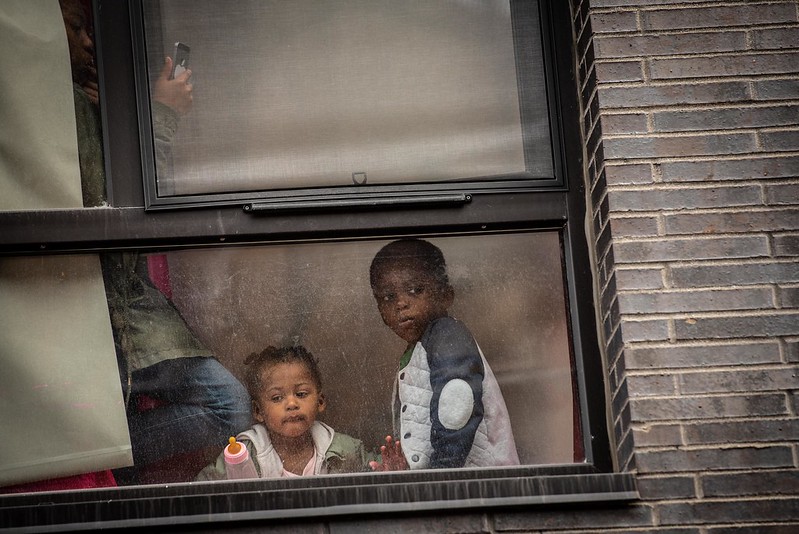
Protect housing for the most vulnerable (photo: Michael Appleton/Mayoral Photography Office)
Five years ago, New York became the first city in the country to create a right to counsel for low-income tenants facing eviction. Unfortunately, this right is now being hollowed out by the combination of a recent explosion of eviction cases and a shortage of tenants’ rights attorneys. Since the beginning of March, housing court judges have compelled at least 18 tenants to participate in their own eviction proceedings without access to a city-funded attorney.
This should not be happening. Our courts have the power to proactively manage their dockets to protect the right to counsel. It is time for them to use it.
Like so many challenges these days, the current threat to the right to counsel has its roots in the pandemic. The stresses of covid, combined with low pay and long hours, have led to a great resignation of young tenant rights attorneys. Our city-funded right to counsel programs have been depleted as a result. The Bronx Right to Counsel program, for example, recently reported that it has lost over a quarter of its tenant rights attorneys.
Tenants might not have initially noticed this shortage of attorneys because a statewide moratorium on eviction proceedings remained in place. That moratorium recently expired. Now eviction filings are skyrocketing.
The long-run solution to this challenge is to replenish the number of tenants’ rights attorneys and to reduce evictions by passing “good cause” eviction legislation. In the short-run, however, our options for protecting tenants are limited. Today, even though city law promises that every tenant earning less than 200% of the federal poverty level has the right to an attorney in eviction proceedings, in practice many cannot get one.
Tenant attorneys are currently overwhelmed, with many reportedly handling 80 cases at a time. Legal service providers are concerned that if attorneys take on even more clients they will not be able to provide quality counsel, putting them at risk of violating their ethical obligations to provide tenants with competent representation.
Our courts must act to protect the right to counsel. In cases where a tenant is entitled to a city-funded attorney but cannot find one, state law empowers housing court judges to adjourn eviction proceedings until an attorney becomes available. New York’s Office of Court Administration could direct housing court judges to use that power to slow the torrent of eviction proceedings to match the availability of tenant attorneys.
Unfortunately, the Office of Court Administration announced that it would not do so. Instead, eviction cases are proceeding double time. Whereas in some courts judges used to hear one eviction proceeding every 30 minutes, they are now reportedly hearing two cases every 15 minutes.
These assembly-line style eviction proceedings are devastating for families. Without counsel present, landlords – who are almost always represented by an attorney – are able to ride roughshod over tenants, who are overwhelmingly low-income Black and Latino New Yorkers.
This only causes unnecessary pain on all sides. Attorneys can often prevent evictions and help landlords get paid. They are able to help tenants access federal funds to cover overdue rent or find other paths to stay in their homes. In fact, according to legal service providers, right to counsel legislation can reduce evictions by more than half. The original Right to Counsel bill, which passed in 2017, was an unconditional success: 84% of families facing eviction stayed in their homes in the program’s first year.
If our courts will not act on their own, we need all hands on deck to solve this crisis. The city’s Office of Civil Justice, which is responsible for working with legal service providers to ensure a right to counsel, should step into the breach. The state Office of Court Administration has signaled that it might be willing to adjust its docketing practices if the city Office of Civil Justice asks it to do so. The Office of Civil Justice should engage the courts immediately to find a speedy resolution.
In addition, the New York City Council, where we are members, must act to prevent our history-making right to counsel legislation from becoming dead letter. If state legislation is needed to reform the Office of Court Administration in order to better safeguard our tenants, the City Council should work with lawmakers in Albany to get this done. Regardless, the Office of Court Administration should set an upper limit on the number of housing cases that one judge puts on their calendar at a time.
Every day, families walk into a court of law, alone, unaided by an expert of the law. Tragically, entering without an attorney often means exiting without a home. Instead of rushing people out of stable housing, the courts must give every New Yorker a true right to counsel by adjourning until an attorney can be provided.
***
City Council Member Shaun Abreu represents parts of Upper Manhattan and chairs the Council’s Committee on State and Federal Legislation, and is a former tenant rights attorney who was evicted from his home as a child. Deputy City Council Speaker Diana Ayala represents neighborhoods in Upper Manhattan and the South Bronx with some of the highest eviction rates in the city and chairs the Council’s Committee on General Welfare. On Twitter @ShaunAbreu & @DianaAyalaNYC.
***
Have an op-ed idea or submission for Gotham Gazette? Email This email address is being protected from spambots. You need JavaScript enabled to view it.
A Critical Opportunity for New York to Increase Care Not Coercion for Those Living with Serious Mental Illness

Health care at the hospital (photo: Jeff Reed/City Council)
Far too many New Yorkers living with serious mental illnesses have been left to languish in our streets, hospitals, jails, and prisons without adequate access to the health care, housing, employment, and other rehabilitative and supportive services they need to survive and thrive.
Thankfully, help is on the way this year. In the next week, the Governor and State Legislature will work to pass a budget launching an unprecedented number of initiatives to help New Yorkers to get ahead of and better manage serious mental health crises and, in doing so, will both advance public health and public safety for all New Yorkers.
With these budget investments, New York will be in a position to help people before a crisis by providing over 1,000 new housing units to help unhoused New Yorkers secure a safe place to stay. We’ll also be able to put 20 new Safe Options Support Teams of trained mental health practitioners out in the community to bring hope and help to those who are at risk of relapse, hospitalization, and incarceration.
This July, we’ll be launching a new 9-8-8 mental health and suicide prevention lifeline system in New York that will offer immediate access to a trained crisis counselor, with follow-up available at newly-developed crisis stabilization and respite centers as needed.
The proposed budget investments would also put upwards of 1,000 psychiatric inpatient beds online across the state that will allow for longer hospital admissions for those in acute psychiatric need.
And we will be providing desperately needed help to our hard-pressed community mental health workforce with the largest cost of living adjustment in recent history.
But what we must not do is to return to the onerous policies of the past and force more people with mental illness to be placed on coercive treatment orders.
The truth is that people who live with severe mental illnesses are eleven times more likely to be victims of violence and five times more likely to be murder victims. By providing care that addresses their most urgent needs, we are keeping them and our entire communities safe.
Kendra’s Law – establishing a system of “Assisted Outpatient Treatment” that is a court-ordered and mandatory detainment of individuals suffering from mental illness – has resulted in glaring disparate racial impacts. Since the program’s start in 1999, four out of five outpatient treatment orders have involved Black and Hispanic people in New York City.
Policies that criminalize people in need and that discriminate based on race will only further disincentivize people from seeking out community-based supports that could have made a difference before a crisis ever occurs.
We know how to help people in the greatest need and we are bringing new programs online that will voluntarily engage large numbers of people who have committed no crimes – saving lives and hundreds of thousands of taxpayer dollars.
Rather than to expand Kendra's Law, let’s use this moment to engage, support, and serve thousands of New Yorkers during times of their greatest need, creating or augmenting essential, voluntary crisis services, hospital care and supportive housing.
***
New York State Senator Samra G. Brouk represents parts of Monroe and Ontario counties, including Rush, Mendon, Pittsford, Perinton, Fairport, Penfield, East Rochester, East Irondequoit, Naples, Bloomfield, Victor, and the east side of the City of Rochester and is chair of Senate Committee on Mental Health. Harvey Rosenthal is CEO of New York Association of Psychiatric Rehabilitation Services (NYAPRS). On Twitter @SenatorBrouk & @HarveyRosentha3.
***
Have an op-ed idea or submission for Gotham Gazette? Email This email address is being protected from spambots. You need JavaScript enabled to view it.
Saving Lives from New York City to Rochester and Beyond
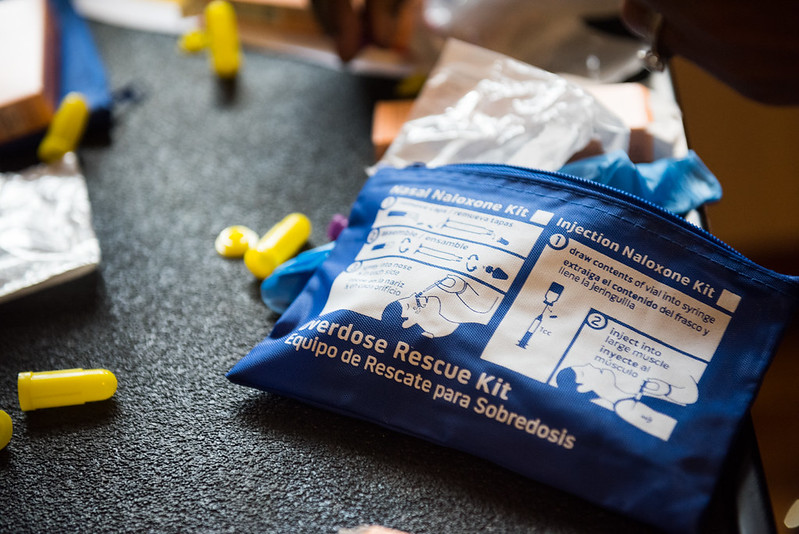
Overdose rescue kit (photo: Edwin J. Torres/Mayoral Photo Office)
The city of Rochester is not immune to our country’s overdose crisis. In 2020, the most recent year we have data from, we lost over 230 people to preventable overdoses in our city, and preliminary data points to that only increasing in 2021. Each person we are losing sends a shockwave through our communities and families, and we cannot give in to the idea that this epidemic is normal or unpreventable.
The reality is, every overdose death is preventable. New York is making history and proving there is a solution that will keep our loved ones alive, and that solution is Overdose Prevention Centers (OPCs).
Right now, New York City is leading the charge on curbing these deaths with the launch of two OPCs in areas of the city hit hard by the overdose crisis. In just two months, well over 100 lives have been saved through intervening in overdoses that could have otherwise been fatal.
It’s not hard to imagine the people we could help and lives we could save in Rochester if we also had OPCs. In truth, we don’t have to imagine — there is legislation on the table right now to authorize these sites to open across the state.
The Safer Consumption Services Act (SCSA), sponsored by my colleagues Senator Gustavo Rivera and Assemblymember Linda Rosenthal, is a concrete step we can take to curbing the overdose crisis in New York. It would authorize local organizations that already serve our communities to add this lifesaving service to their existing programming.
If the lives saved at New York City’s two initial sites isn’t evidence enough, OPCs have been successful for over 35 years with over 120 centers around the world. And the best news: not a single person has died of an overdose on their watch.
The benefits of this legislation stretch much farther than ending the overdose crisis we have on our hands. OPCs create spaces where health-care providers can connect and build trust with people who use, and connect them with public health tools to keep them, and the communities they belong to, safe and alive. In addition to saving over a hundred lives, the OPCs in New York City have provided wraparound services to hundreds of community members. Hepatitis C testing, sterile syringe exchange, and mental health counseling—all of which can help get people into long-term substance use treatment if that’s what they want—are also offered to participants at OPCs.
OPCs are also a critical tool in preventing the spread of HIV, where rates of transmission have led to a cluster of HIV cases in Monroe County. In 2020, more than 50 people were diagnosed with HIV–a number that has likely risen–as a direct result of the years of underfunding of harm reduction services before and during the pandemic. It’s my responsibility to the people of Rochester to course-correct and do everything in my power to prevent more harm from being done.
The numbers speak for themselves, but unfortunately, the opposition speaks loudly. Those with a political agenda lean on tired, dangerous, and false narratives that any harm reduction tool will enable drug use. This couldn’t be farther from the truth. Like so many harm reduction strategies already widely used in New York, spaces dedicated to keeping people alive will not encourage more drug use, but will keep all of the community safe, and provide people with the services that they need. OPCs will bring our loved ones out of the shadows and away from public use and into the care of medical professionals.
The state of New York is in the midst of a watershed moment. We can either choose to meet the overdose crisis with proven solutions and compassion, or we can continue with the same failed approaches that criminalize people who use drugs without offering any real help. I refuse to accept that the way things have been done is the only way they can be.
We have the answers in front of us, we have the care providers who are willing to step up, and we have the need in our community. It’s time for overdose prevention centers to become a reality across the state, and with the Safer Consumption Services Act, I hope to see as many lives saved in Rochester as in New York City. It’s time to get it done.
***
Demond Meeks serves as the Assembly member for District 137 and is a native of Rochester. On Twitter @DemondLMeeks.
***
Have an op-ed idea or submission for Gotham Gazette? Email This email address is being protected from spambots. You need JavaScript enabled to view it.
New York Leaders Must Not Let Health Insurance Companies Coopt Patient Protection Law
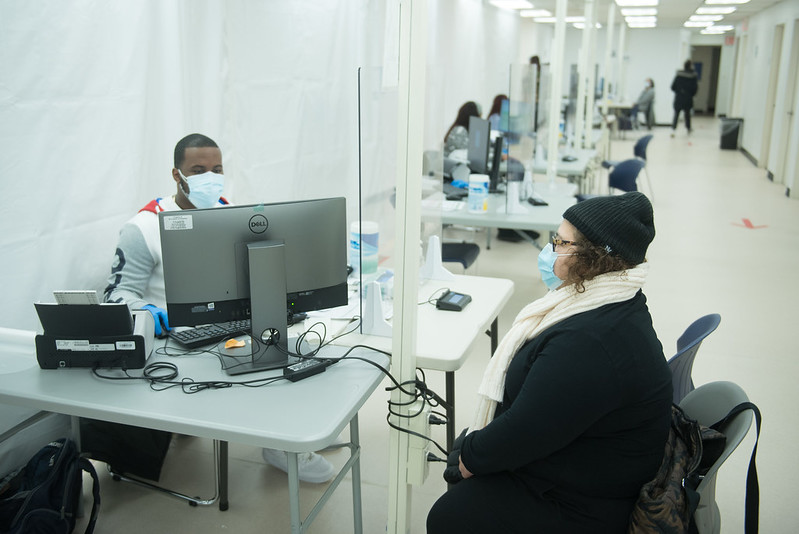
Seeking health care (photo: Michael Appleton/Mayoral Photography Office)
In 2014, New York became the first state to enact a law addressing surprise medical bills. Congress followed suit in 2020 with the No Surprises Act.
Now, as Governor Hochul works to put New York law in line with federal standards, health insurance companies are attempting to co-opt the law with a one-line provision they lobbied for in Hochul’s budget proposal that would put health-care providers at a disadvantage in billing disputes. If approved by the Legislature, this biased proposal will threaten access to life saving emergency care while boosting health insurers’ already record-breaking profits.
Surprise medical bills, which have long plagued the U.S. health-care system, occur when a patient receives care from an out-of-network physician, usually in an emergency room or in an outpatient setting where the patient was unaware that the attending physician was out-of-network, and the insurer refuses to pay.
For years, surprise bills placed a heavy burden on American families, leaving them to cover the entire cost of emergency care as insurers collected increasing premiums. By implementing a dispute resolution process for out-of-network care, New York’s landmark surprise bill law rightfully ensured that out-of-network billing is resolved between insurers and providers, relieving patients from having to pay for life-saving emergency care out of pocket.
New York’s surprise bill law became the model for the federal No Surprises Act – and for good reason. In the first three years following its implementation, the New York State Department of Financial Services found that the law saved consumers over $400,000,000. The process is both fair and accessible, allowing each side to present its best offer to an independent arbitrator who in turn selects the most reasonable proposal. In doing so, the model encourages disputing parties to submit fair claims to the arbitration process while ensuring that neither party has extra influence over the decision.
But the governor’s Executive Budget contains a provision to mandate that dispute resolution arbitrators consider the average payment an insurance company would reimburse in-network providers, also known as the qualifying payment amount, or QPA. Expressly mandating inclusion of median reimbursement amounts – which are already permitted for consideration in the existing dispute resolution system – in the arbitration process would provide a significant advantage for the insurer.
If enacted, the inclusion of this amount would lead more physicians to lose out in the dispute process. How so? The insurance company rate is by no means a verifiable market rate charged by physicians day in and day out. Instead, it is reflective of insurance companies’ market power. Using these same metrics, an American Hospital Association survey found that Medicare reimbursement was $53.9 billion lower than actual costs. For patients, this formulation would be disastrous, as health-care professionals would be less likely to provide emergency care and other services.
Simply put, these payment cuts would lead many of the affected practices to close their doors. That leaves patients without the care they need. Moreover, this budget language is not required by federal law; in fact, Texas’ Eastern District Court rejected similar provisions shoehorned into regulatory code last month.
Despite this, it is no surprise that insurance companies – ever eager to squeeze more profit out of patients and providers – have identified New York as the next frontier for tipping the dispute resolution scale in their favor. The Legislature has rejected all surprise billing language, both the good and bad, from their one-house proposals, but who knows what will end up in the final budget deal due by April 1.
Health insurance companies are massively profitable and have exploded in value in the last decade. Take, for example, UnitedHealthcare, whose stock was trading at around $50 per share in March of 2012; ten years later, UnitedHealthcare’s stock trades at around $500 per share. Despite record growth and profits, insurers continue to raise premiums without expanding coverage, increasing the already heavy burden of health-care costs for American families. The new provision in the Executive Budget is a transparent power grab by the industry that would accomplish nothing for patients and providers while feeding insurers’ ever-growing profit margins.
The blockbuster success of insurers in recent years stands in stark contrast to the situation facing many independent medical practices in New York and across the country. When COVID-19 first swept across the country in 2020, and as the Delta and Omicron variants surged last year, health-care providers had to halt elective procedures, losing a key stream of income, while many patients opted to delay or even forgo care entirely. When the federal government allocated aid for hospitals in response to the pandemic, the vast majority of funds went to large hospital systems, with some like Northwell Health receiving upwards of $1 billion. Small, independent providers, on the other hand, have been largely left out to dry by Uncle Sam.
If the new provision being pushed by insurance companies is passed, the impact on independent providers and the communities they serve will be devastating. A dispute resolution process tilted in favor of insurers will drastically reduce revenues for providers – while large hospital systems may be able to absorb such a blow, many small and independent practices could be forced to close their doors, costing important health-care jobs and reducing the number of options available for patients.
Health insurance companies, it seems, will never be satisfied with record-breaking profits. Always seeking to extract more profit from hard-working New Yorkers, insurers have spared no effort in trying to subvert the state’s surprise bill statute, impact on providers and patients be damned. The question remains: will our leaders stand up to the insurers, or will they be allowed to subvert the law for their own profit?
***
Christopher Sheeron is president at Action for Health, a nonprofit advocacy organization dedicated to ensuring fair outcomes for critical healthcare issues.
***
Have an op-ed idea or submission for Gotham Gazette? Email This email address is being protected from spambots. You need JavaScript enabled to view it.
Time for New York to Act: Everyone Deserves Quality Health Care, No Matter Their Immigration Status
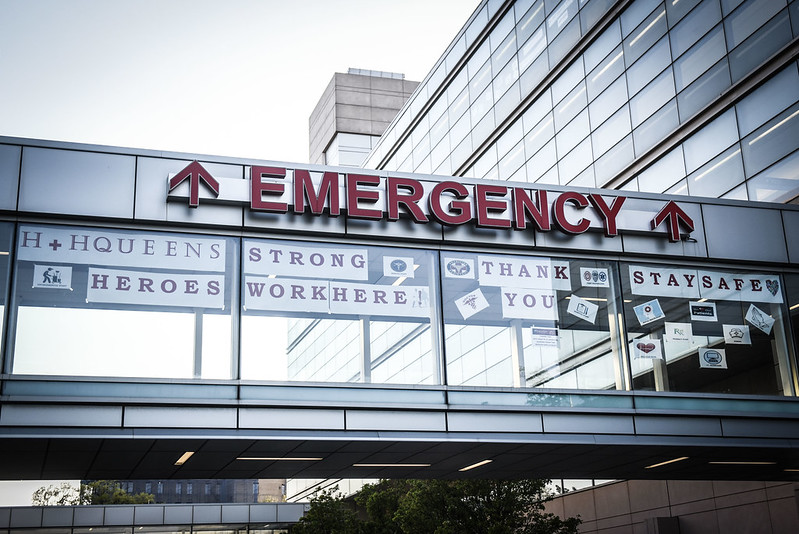
Avoiding the emergency room (photo: Michael Appleton/Mayoral Photography Office)
Mateo first came to the United States to be a caregiver for his terminally ill brother, who had cancer. Shortly after his brother passed away, Mateo went to a regular doctor’s check-up. He had not been feeling well lately. After further tests, doctors determined that his kidneys were failing. Since then, Mateo has been reliant on hemodialysis, a treatment intended to help a patient with kidney failure survive while they wait for a transplant.
But Mateo is not able to get on a waitlist for the kidney transplant that would save his life. Why? He is one of the estimated 400,000 undocumented and uninsured immigrants in New York state. Despite the contributions immigrants like Mateo make every day to our community as well as to the economy, New York leaves them without support when they need it most.
At the onset of the pandemic, Mateo contracted COVID-19. He had to be hooked up to a ventilator and nearly died. Unfortunately, Mateo’s experience is not uncommon for immigrants in New York.
Our state has spent the last two years fighting against the spread of COVID-19, and immigrants have played a huge role. They pay billions in taxes every year and serve as essential workers on the front lines of the fight against COVID-19. And yet they are systemically left without access to health care. The pandemic has shown how essential that care can be: it is estimated that over 2,000 undocumented New Yorkers died from COVID-19 due to a lack of health coverage.
This is the daily reality for Mateo, who uses Emergency Medicaid, the only form of insurance he is eligible to receive. Emergency Medicaid only covers the treatment of severe “acute symptoms” that threaten an individual’s health. This means that Mateo’s dialysis is covered, but the treatment of other conditions that intersect with kidney failure (such as heart problems and loss of vision) are not – and neither is a kidney transplant. While undocumented immigrants can be organ donors, they are excluded from receiving organs themselves. New York benefits greatly from the contributions of immigrants like Mateo but does not give back to them to anywhere near the same degree.
Preventive care has the potential to save both money and lives; the Centers for Disease Control and Prevention estimate that about 90% of annual health expenses go to treatment of chronic physical and mental health conditions, many of which are preventable and treatable when addressed early. However, preventive care is not included in Emergency Medicaid coverage, which many immigrants rely on. Had Mateo been able to visit the ophthalmologist when his doctor recommended it, his eyes may not have suddenly started bleeding, requiring surgery. Due to the cost, he has also had to put off visiting a cardiologist despite the urging of his doctor.
Providing only emergency care is simply not enough. Mateo’s trips to dialysis three times per week are only intended to help him survive while he waits for a transplant. Once one’s kidneys have failed, they cannot be recovered; a transplant is the only permanent solution.
Mateo’s experiences demonstrate how a lack of insurance prevents immigrants from accessing the care they need. Many uninsured individuals may delay going to the doctor until it is too late due to an inability to pay. Health problems like heart disease, diabetes, or other chronic illnesses are known to make one more likely to get severely ill with COVID-19. While these conditions may be treatable or preventable, uninsured immigrants are left as though those treatments don’t exist, instead forced to face the serious and often fatal consequences of a condition that has been treatable for decades.
Luckily for Mateo and other immigrants like him, there is a solution. A proposed state law, (A880A/S1572A), would create a state-funded Essential Plan for all New Yorkers earning up to 200% of the federal poverty level, regardless of immigration status. If this law were passed, Mateo and thousands of others would be able to access the life-saving medical coverage they need and deserve. Other states are expanding access to health care in similar ways, including California, Minnesota, and Illinois. New York cannot be left behind on this. All New Yorkers deserve access to healthcare, no matter what their immigration status.
Immigrants are at the heart of New York’s communities: they are friends, parents, children, colleagues and partners. They pay taxes, work as essential workers and donate their organs. Still, many are left out of necessary health coverage. They contribute just as much as their neighbors who have citizenship, yet they receive far fewer benefits. This blatant discrimination is unacceptable. New York must pass coverage for all to ensure that every New Yorker, no matter their immigration status, has access to quality health care.
***
Emily Hodgkins is a Post-Graduate Legal Fellow in New York Lawyers for the Public Interest’s Health Justice Program.
***
Have an op-ed idea or submission for Gotham Gazette? Email This email address is being protected from spambots. You need JavaScript enabled to view it.
Turn to Communities to Turn Around New York’s Unprecedented Health Disaster
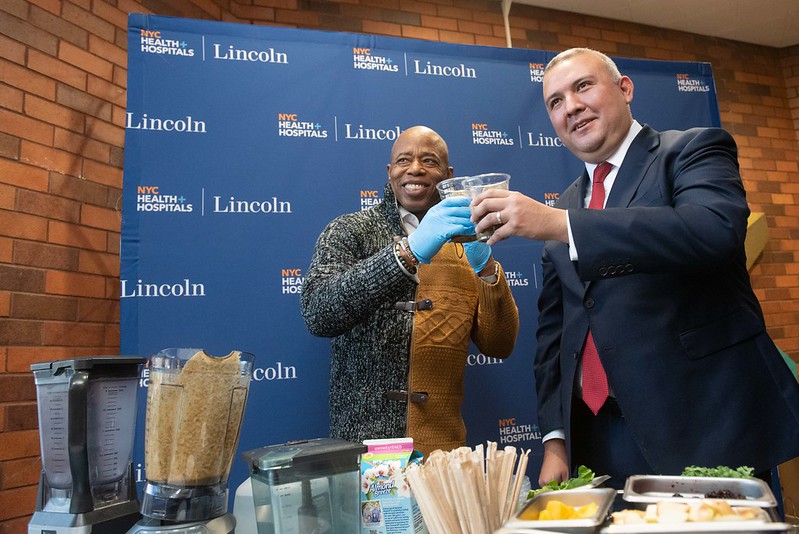
Mayor Adams promotes good health (photo: Michael Appleton/Mayoral Photography Office)
New York City and State face unprecedented mass illness--from chronic disease that has been allowed to fester for decades, ongoing endemic COVID-19, and uncountable already existing cases of Long Covid--plus rising overdose rates and emergency illness from drug use, and more. With all this, mass trauma has overtaken whole communities. There will never be sufficient professional personnel, from clinicians to police officers, to contend with this unprecedented nightmare.
What to do?
Let’s go back 30 years to when the epidemic of HIV/AIDS collided with the staggering crack epidemic, creating similar conditions. What happened then was a formidable lesson. As systems simply broke down, communities themselves actually stepped in to slowly but surely rebuild themselves.
As the worst-hit AIDS communities began to undertake education and prevention for themselves, the important phenomenon of peer education--reaching high-risk people through outreach by others from their community---for the first time gained widespread use in New York. The Gay Men’s Health Crisis (GMHC), started to fight AIDS, massively fielded peer educators. “Harm reduction” services, largely conducted by recovering drug users, for the first time widely reached addicts. With these efforts, new HIV infections plunged even before effective treatment for HIV/AIDS became available.
In sum, peer educators, often from the most vulnerable and poorest communities, some lacking even a high school degree, made themselves into a never-before-seen force for progress in community health.
One difference today is that the situation is far, far worse. With their billions in federal recovery money, the state and city must now widely support peer initiatives that rebuild community health.
Peer support can be attached to clinical services as seen at Fountain House, the outstanding mental health program that New York City’s new health commissioner, Dr. Ashwin Vasan, led for years. But peer services fielded directly by community groups also achieve remarkable progress.
One area for immediate attention is diabetes and other major chronic diseases, which both the city and state simply ignored during the de Blasio and Cuomo years. Our public health departments are playing with fire, and abandoning their core responsibility by even now continuing to let chronic disease climb and refusing to support proven peer-delivered self-care education in the neighborhoods most in need.
The impact of widely available self-care education on reducing the human toll and public cost of diabetes alone would be staggering.
One million New Yorkers have diabetes, which is also a “gateway” disease that worsens stroke and heart disease and causes some 90% of lower-limb amputations and 45% of dialysis cases.
The Diabetes Self-Management Program (DSMP), a six-session course that is the best-known diabetes self-care course, reduces blood sugar--which immediately reduces vulnerability to the worst covid outcomes--as well as overall complications and costs. It also lowers the high rates of co-morbid depression seen in diabetes, improving the city’s frighteningly deteriorated mental health. And, evaluation repeatedly shows that it slashes emergency room visits by 40% or more—an extraordinary benefit in relieving the overwhelming pressure now on front-line clinical staff.
By using peers, this critical self-care education can be launched quite quickly. When my South Bronx organization had special federal funding (now terminated), we instituted a four-week program to train low-income people with diabetes or pre-diabetes to deliver the DSMP. These peer educators, being from the community, fanned out to dozens of community sites--churches, homeless shelters, mental health programs, public housing where they already had connections--and enrolled almost 2,000 Medicaid recipients with Type 2 diabetes in the DSMP.
This was evidently the largest community mobilization for diabetes self-care education ever to occur in the United States, and there are capable community groups across the city who could learn to get the DSMP up and running.
Through new relationships it formed with dozens of community groups during covid and the Adams administration’s new office of Faith-Based and Community Partnerships, among other entities, the city could create an army of peer educators never seen before, with the capacity to deliver effective chronic disease self-care education, in multiple languages, to almost every corner of the New York, measurably renewing health.
Not incidentally, when my organization took the DSMP to homeless shelters, the city Department of Health’s own evaluation showed a 45% drop in participants’ emergency room visits.
Yet, neither the New York City nor New York State department of health has ever spent a penny to support the DSMP, or other proven chronic disease education delivered by communities, themselves.
We can much hope that will change with the new Adams and Hochul administrations; but change must be soon. The longer people remain massively sick without intervention to improve their self-care, the sicker and sicker they get, and the more vulnerable they remain, even two years later, to the worst that COVID-19 does.
***
Chris Norwood is Executive Director of Health People, the community preventive health institute. On Twitter @HealthPeopleOrg.
***
Have an op-ed idea or submission for Gotham Gazette? Email This email address is being protected from spambots. You need JavaScript enabled to view it.
An Inclusive Economic Recovery Will Prevent Crime
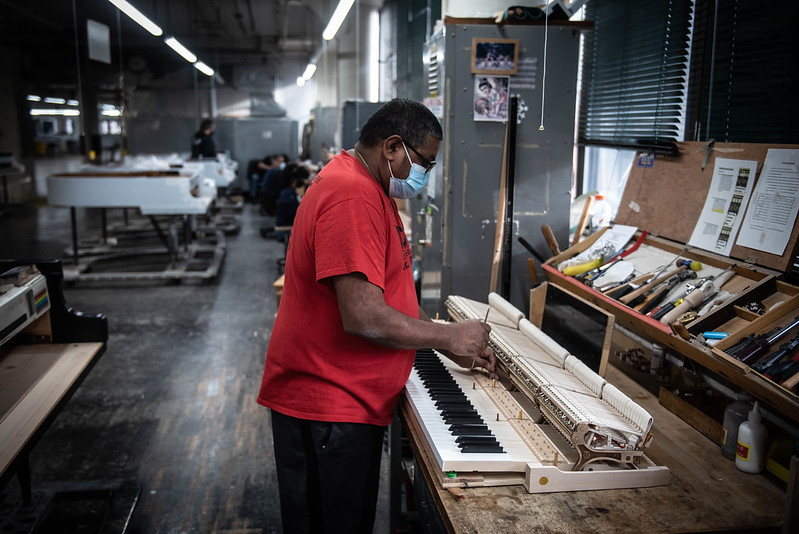
On the job (photo: Michael Appleton/Mayoral Photography Office)
Roughly a decade has passed since New York City experienced crime rates and unemployment rates as high as they are today. That is no coincidence: although crime has many contributing factors, joblessness is a primary cause.
While we need immediate interventions to stop violence now, the best antidote to crime in the long run is a growing and inclusive economy. That is why, as New York recovers from the pandemic, we must invest in workforce development programs that give our young people the chance to choose careers over crime.
This issue is personal for me. Growing up as the son of two community street vendors in Washington Heights, I watched some of my peers make decisions that had a devastating impact for themselves and others. And so, after becoming a first-generation university graduate and receiving my Master in Social Work, I came back to Inwood and Washington Heights to work with at-risk youth.
But today, these communities—and other communities like them—are facing persistent joblessness. Before covid struck, roughly one-in-ten workers in Washington Heights and Inwood worked in a restaurant. With the overall restaurant workforce still 30% below pre-pandemic levels, too many men and women remain out of a job. Other low-wage workers, like those who used to be employed in midtown office buildings, may not see their jobs return for years.
This leaves too many unemployed people, including our youth, looking for some way—any way—to earn a living. Providing these jobless workers with the skills and opportunity to participate in the post-pandemic economy is critical to warding off future violence in our communities.
What we need now is a generational investment in workforce development programs that is guided by three fundamental principles to ensure their success.
First, we must adopt a people-centered approach to workforce development. New York’s current program-centered approach funds a laundry list of initiatives and asks people to navigate their way through them. As a social worker, I know that far too often people fall through the cracks. A people-centered approach would identify unemployed workers and at-risk youth early, understand their needs, and then move them seamlessly from skills-development programs through to job placement.
Second, we must scale up workforce development approaches that we know work. Some of the best workforce development programs in the country were started here in New York City.
For example, Per Scholas—a program that trains young people from low-income families to enter the tech industry—started in the Bronx and has a proven track record of boosting the livelihoods of its graduates. Rather than spreading funding thin across a hodgepodge of programs, New York should invest in expanding programs that succeed.
Third, we must build new partnerships to drive workforce development in our communities. This means partnering with unions, universities, colleges, and businesses so that workforce development programs prepare people for the jobs of today. In addition, we should explore proposals from places like the Center for an Urban Future and Jobs First NYC that would bring real-estate developers to the table so that they contribute to workforce and economic development in the communities where they own buildings.
Of course, a smarter approach to workforce development will be meaningless unless backed by serious cash. That is why I will fight to ensure that Governor Hochul’s budget request for $350 million for workforce development is fully funded in the next state budget.
And, that is why I strongly support Mayor Adams’ recent announcement that New York City will support 100,000 summer job opportunities for young people. When necessary, I will fight for more state money to support initiatives like this. But I will also stand as a watchdog to ensure that those funds are spent wisely so that our young people benefit.
Mayor Adams is fond of quoting the wise words of the recently deceased Archbishop Desmond Tutu: “We need to stop just pulling people out of the river. We need to go upstream and find out why they're falling in.”
Having grown up in Washington Heights and Inwood, and after a career working with at-risk youth in my community, I too am tired of pulling people out of the river. If we make meaningful investments in workforce development today, we can finally limit the number of them falling into the river in the first place.
***
Manny De Los Santos was recently elected to the New York State Assembly to represent the 72nd Assembly District, which includes Washington Heights, Inwood, and Marble Hill. On Twitter @AMDeLosSantos72.
***
Have an op-ed idea or submission for Gotham Gazette? Email This email address is being protected from spambots. You need JavaScript enabled to view it.
New York Needs to Protect Medicaid Members in the State Budget
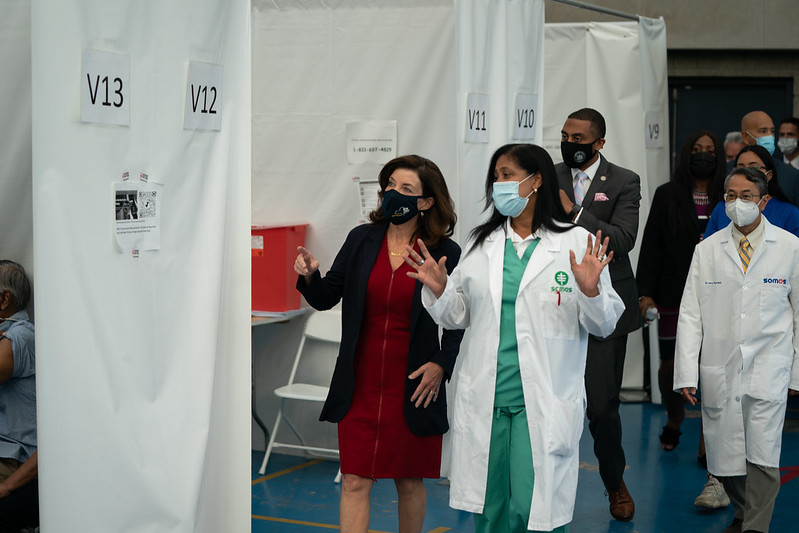
Good health care is essential (photo: Don Pollard/Governor’s Office)
More than 5.5 million New Yorkers rely on Medicaid managed care health plans for their care. Many of these members are among the state’s most at-risk residents, with multiple health conditions that require coordination of numerous services. This includes both physical health and mental health care, long-term services and supports, as well as help coordinating social services, such as housing, employment, education, and food access. They often rely on Alzheimer’s Disease Resource Center (ADRC) and other community-based organizations to help them navigate the health-care system and access the care and services they need.
Unfortunately, a provision in Governor Hochul’s proposed state budget for the upcoming fiscal year will take away choices from patients, create havoc in the delivery system, and undercut efforts to promote health equity.
The proposal would direct the Department of Health to reduce the number of health plans in the Medicaid program to no fewer than two but no more than five in each region of the state. Hundreds of thousands of individuals will be forced out of their current plan, disrupting their care and potentially forcing them to switch providers.
As an organization that provides care, support and education to families facing Alzheimer’s disease and other dementias, we’re concerned that it will make it harder for the people we serve to get the services they need. If their current plan is eliminated, the disruption in care will also impact the families who are already often overwhelmed with their caregiving responsibilities.
The proposal also runs counter to the state’s goal of promoting health equity. Underserved populations, including communities of color, have been disproportionately affected by the pandemic. Taking options away from Medicaid members doesn’t just threaten the ability of providers to support their patients but will undercut efforts to address racial and ethnic disparities in care. While New York’s Medicaid program has been a national leader in improving quality and health-care outcomes, the challenges this proposal will cause to coordinate care has the potential to threaten those efforts.
Despite the health and economic impact of the pandemic on the state, New York’s uninsured rate dropped to less than 5%. Medicaid has played an important role in providing a safety net in the middle of a global health crisis. Unfortunately, the governor’s proposal will take away resources from other important health priorities.
For example, as the public health emergency ends the state will have to recertify eligibility for every Medicaid member. Taking options away from patients will make it harder to ensure that low-income individuals stay covered as they try to navigate these changes.
It is more important than ever to protect the choices available for vulnerable New Yorkers who rely on the Medicaid program. The state should not make it more difficult for New Yorkers with complex health conditions to get the care they need. Considering the level of disruption the proposal will cause for patients and providers, the governor and Legislature should drop this policy proposal from the state budget that is due by April 1.
***
Robin Marks is Executive Director of Alzheimer’s Disease Resource Center. On Twitter @adrcinc.
***
Have an op-ed idea or submission for Gotham Gazette? Email This email address is being protected from spambots. You need JavaScript enabled to view it.
Latinos and the 2022 Democratic Primary
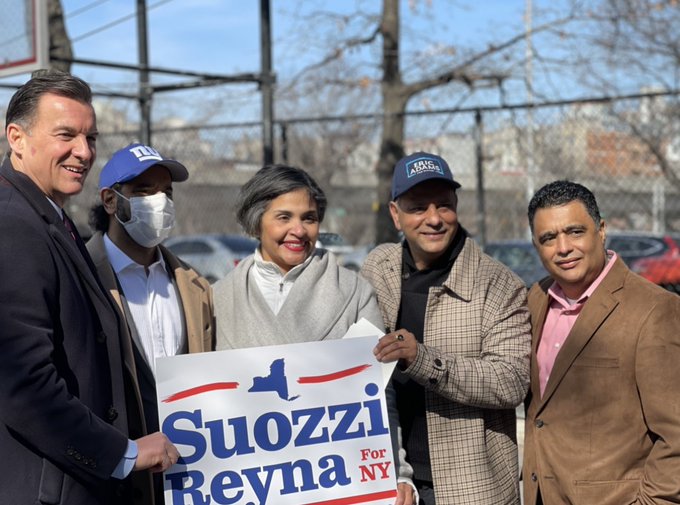
Suozzi-Reyna (photo: @Reyna4NY)
The Latino vote in New York is, thankfully, becoming the important point of conversation it should be. While there’s a ways to go, there is more discussion happening -- including a variety of political debates, via the inimitable work of Errol Louis in one of his recent columns as well as a podcast episode he dedicated to the Latino vote with me as his guest, and through this series of pieces and associated podcasts published by Gotham Gazette, among other sources.
I have sought to explicate the intricacies of this burgeoning ethnic group for a number of years, largely through this platform. Despite the increased attention, Latinos seem to still often be an afterthought for many elected and party officials, as was made evident by the recent selection of speakers at last month’s state Democratic convention. No Latinos were on the original list of speakers, and it was only after a number of prominent Latinos complained about the snub that party officials scrambled to include three Latinos on the list.
Snubbed or not, disregarded or not, Latinos are and will continue to be an important voting constituency in New York City and State elections. Some politicians understand this, like Tom Suozzi, a member of Congress who is now aspiring to defeat Governor Kathy Hochul and others in June’s Democratic primary. Suozzi not only named former Bronx Borough President Fernando Ferrer the chair of his campaign; he also named Diana Reyna, former City Council member and deputy Brooklyn Borough President, as his lieutenant governor running-mate.
New York City Public Advocate Jumaane Williams, also running for the Democratic nomination for Governor, and his supporters in the Working Families Party also appear to be aware of the importance of the Latino vote, as they recruited Ana Maria Archila to run for Lieutenant Governor as Williams’ running-mate. (Candidates for governor and lieutenant governor are not linked on the primary ballot, but they often present themselves to voters as running-mates.)
Will Latinos play a key role in who wins the governorship this year? Will Latinos defy previous voting patterns and turn out to vote in larger numbers?
The answer to the first question is a clear yes. The second question is more complicated, and my answer will come in the form of a challenge.
According to my analysis of voter rolls, Latinos are currently 18% of the entire state Democratic electorate, with 1,152,950 voters across the Empire State. This 18% represents the largest share of Latino Democratic voters in state history. Of the 1.15 million Latino voters, 862,255 are in New York City. That is a whopping 75% of the Latino electorate in the five boroughs.
Hence, any statewide candidate who does not visit the storefront cuchifritos in East Harlem or devour the excellent mangus at establishments in Washington Heights and the Bronx or stop by the taquerias in Sunset Park and visit the tree-lined streets of Corona and Elmhurst, will do so at their own peril.
Voter registration numbers, however, are not necessarily the equivalent of voting power. Voting power for Latinos will come once Latinos recognize that proper political representation and adequate policy attention to their plight can only come through robust and consistent voting participation.
As for proper representation, its lack is evident given the fact that among state legislators in New York City, only 17% are Latino, though Latinos represent 29% of the entire city population.
While Latinos continue to increase in the voting population, the fact remains that only 14% of the entire Democratic electorate in the last gubernatorial primary was Latino. To be sure, the low turnout rates among Latinos is not a dilemma unique to New York, as I have mentioned here before. Yet the dilemma is here and must be dealt with.
On a more positive note, that 14% in 2018 was an increase compared to previous years, and even more importantly, since that last gubernatorial primary, Latino voting participation in New York City has already increased by 4% in the 2020 and 2022 primaries.
If the patterns of the last few years continue, I can foresee a scenario in which close to 250,000 Latinos could turn out statewide to vote in this June’s Democratic primary. This would represent the largest ever turnout among Latinos in New York.
What can contribute to this potential increase of Latino voters?
One potential for increased Latino voting participation could lie in the fact that there could be two Latinas on the ballot for lieutenant governor, Reyna and Archila. Having two Latinas vying for the same position -- against incumbent Lt. Gov. Brian Benjamin -- may not be the most conducive to success for their respective candidacies. Such a scenario pits two Latinas against each other, potentially splitting the Latino vote for this position. Yet the Archila and Reyna candidacies can be a potential boon for Latino voting participation, provided that their campaigns invest enough resources (money, time, personnel) in Latino communities.
Archila’s and Reyna’s candidacies could be a bigger boost for Latino voters than the candidates at the top of the ballot—expected to include Hochul, Suozzi, and Williams, to name the top tier.
Previous studies point to increased voting among Latinos when viable Latino candidates are on the ballot. The well-respected Latino political scientist Matt Barreto, with Mario Villareal and Nathan Woods for instance, have studied Latino voting patterns in high density Latino precincts in California and observed that the highest Latino turnout rates in Los Angeles occurred when a Latino was at the top of the ballot for mayor, both within the nonpartisan primaries and in the general elections.
I have used an analysis like Barreto’s to investigate Latino voting patterns in New York and have also found that Latino voting participation has increased when a viable Latino has been at the top of the ballot.
When observing Fernando Ferrer’s candidacy for mayor of New York City in 2001, I noted an increase in voter participation within the New York precincts with the highest Latino populations in comparison with other mayoral primaries when a viable Latino was not on the ballot. In fact, voter participation in heavily Latino precincts increased an average of 30-40% in 2005, when Ferrer became the first Latino to win a Democratic mayoral primary, compared to years with no Latino candidate at the top of the ballot.
While the position of lieutenant governor is not atop the ballot, it still is a position of importance (though not so much in the day-to-day practical operations of state government), as is evident in the Cuomo saga and the eventual rise of Kathy Hochul to the governorship. This election cycle may be the first time that viable Latino candidates will appear on the ballot for a statewide position. And for this reason, provided that the Williams-Archila and Suozzi-Reyna tickets invest in the Latino vote, there is real potential for an increase in Latino voting participation.
What role might the Kathy Hochul-Brian Benjamin ticket have in bringing out the Latino vote this June? Up to this point, I have not seen the necessary investment on the part of Governor Hochul or the state Democratic Party apparatus in the Latino vote as a possible motivating factor for an increase in Latino voting participation. Outside of a few Latino appointments, and some holdovers from the Cuomo administration, Governor Hochul has not done much to increase Latino representation in state government.
At the time of this writing, only 5 of the 16 Latino New York City based state legislators have endorsed Hochul’s candidacy. Only two Latino New York City Council members have endorsed Hochul. And I have already noted how the state Democratic Party snubbed Latinos at its recent convention.
It may take two Latinas -- Archila and Reyna -- to help wake the sleeping giant that is the Latino vote in New York. It will of course take many others to contribute to the rise of Latinos in New York, but perhaps a lot more rests upon the shoulders of Archila and Reyna than they might think.
***
Eli Valentin is an adjunct lecturer at Union Theological Seminary. He writes regular columns for Gotham Gazette, largely focused on Latino politics in New York City, and is a frequent guest political analyst at Univision NY. On Twitter @EliValentinNY.




